SATURDAY
JUNE 22 - 2019 - Portsdown Hill East
Ros Norton
reported on today's walk
A select group of 5 met in the car park near the
George Inn, Portsdown Hill and walked east in the Fort
Purbrook area on a sunny morning.
We admired the Sainfoin growing close to the car park
in an area of long grass. We then crossed the road and
did a circular anticlockwise around the paths south of
Fort Purbrook and nearby verges ending up with a visit
to the field of long grass just east of the car
park.
Highlights included a large number or pyramidal
orchids and some common spotted orchids and a few bee
orchids . There were a large number of marbled white
butterflies, a few meadow browns, and a blue and a
white butterfly. Cinnabar moths and a mint moth were
seen.
Among the birds seen or heard were 2 ravens being
mobbed by crows, a buzzard, kestrels, swifts,
skylarks, goldfinch, wrens and greenfinch.
There were too many plants in flower to list all but
some of the highlights were agrimony, vipers bugloss,
tufted vetch, kidney vetch, rest harrow, knapweed
broomrape, birdsfoot trefoil, milkwort, columbine,
greater knapweed, creeping cinquefoil, field madder,
field bindweed, hemlock, hogweed, wild carrot, wood
avens, meadow buttercup, vervain, black medick, yellow
rattle, woody nightshade, St Johns wort, common
mallow, crossword, ox-eye daisy, hedge bedstraw,
yarrow, bladder and white campion.
SATURDAY
JUNE 15 - 2019 - Brook Meadow
Brian Fellows
led and reported on today's walk on Brook Meadow
I was very pleased to meet up again with several
friends from the old Havant Wildlife Group to lead
this morning's walk on Brook Meadow. Nine of us
assembled in Bridge Road car park where I invited them
to look at a rare plant called Sulphur
Cinquefoil (Potentilla recta) which was in flower
on the wayside.
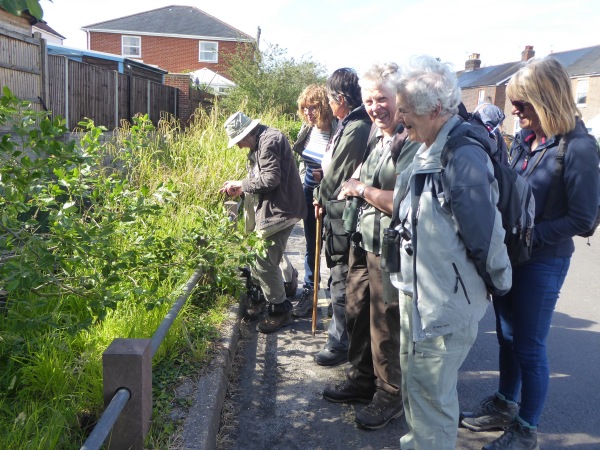
Unlike the more common
Creeping Cinquefoil, Sulphur Cinquefoil is an erect
plant with a cluster of flowers at the top of the
stem. It is a regular plant on this wayside where I
have recorded it most years since 2011. It is
described as 'Rare' in my old copy of 'The Flora of
Hampshire' (1996), though I am not sure what its
present status. It was introduced into Britain by
1648, and was known from the wild by 1858 (Middlesex),
so it is fairly well established though still rare in
this area.
From the car park we
made our way to Brook Meadow via the Seagull Lane
entrance. First we looked at the English Oaks which
the group has planted on this site, including those
which I and my wife planted in Jubilee year 2012. All
the trees have been carefully maintained by the
conservation group and are in excellent health. Here
is a photo the group took of me now dwarfed by the
tree I planted.
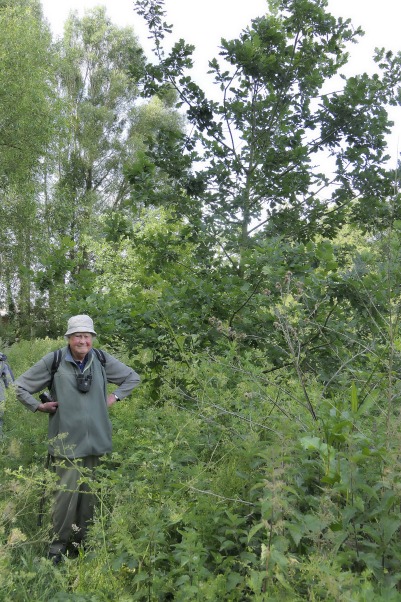
I also pointed out the
American Red Oak planted in memory of our
erstwhile colleague Tony Wilkinson. Derek got this
image of acorns just starting to develop.
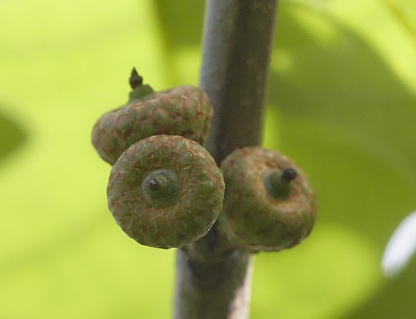
We went over the north
bridge and along the north path by the railway line
where I pointed out a hole in a Crack Willow which
houses a nest of Tree Bumblebees (Bombus
hypnorum). It is a ginger species with a
distinctive darkened abdomen and a white tail. We saw
a number of bees coming to and from the nest while we
were present. This Bumblebee is a newcomer to Britain
having colonised our country in 2001. It is a very
welcome arrival!
We walked down the
east side of the north meadow admiring the wonderful
array of grasses, swaying in the breeze. We noted in
particular the delicate panicles of False Oat-grass
(with awns on its spikelets) and the beautiful reddish
anthers of Cocksfoot.
When examining the
grasses, we paid homage to the memory of our erstwhile
colleague and excellent botanist Gwynne
Johnson. We also admired the developing fruits on
the Rowan plantation that was planted in Gwynne's
memory in 2005. Like the Oaks, these trees are being
carefully tended to by the conservation group.
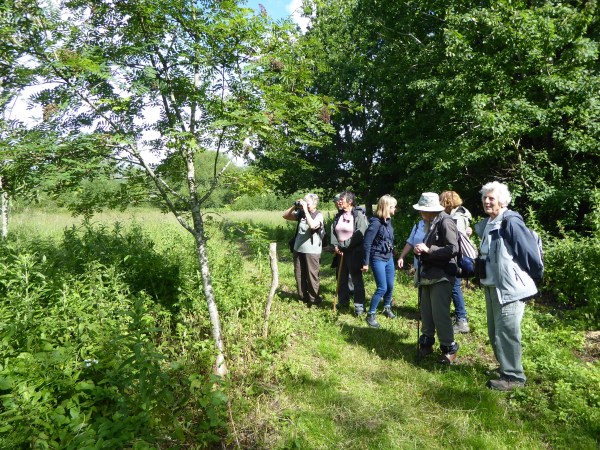
Here is a link to a
tribute page to Gwynne . . . Gwynne
Johnson
We stopped by Beryl's
seat to examine the rare Hybrid Fescue (x
Festulolium loliaceum) which has characteristics
of its two nearby parent grasses, namely Perennial
Ryegrass and Meadow Fescue, ie Ryegrass arrangement of
Fescue-like spikelets
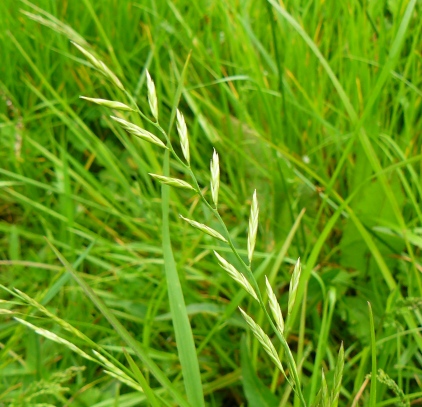
I asked the group to
follow me closely onto the main orchid area and to be
extra careful not to tread on any small
orchids.
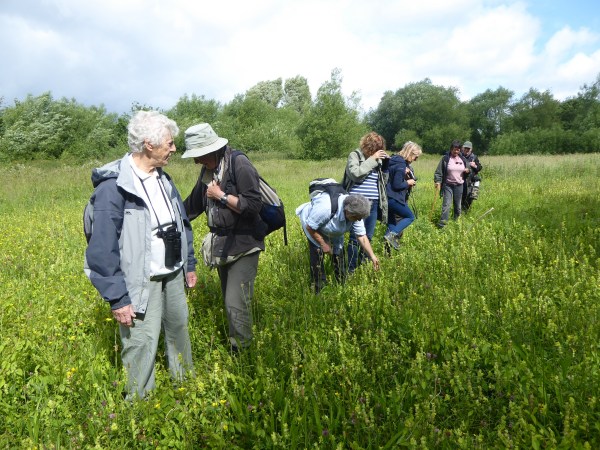
Everyone was delighted
to see the multitude of Southern Marsh and Common
Spotted Orchids along with a scattering of the smaller
more delicate Bee Orchids and the single Pyramidal
Orchid.
The attractive
(orchid-like) flower spikes of Hedge Woundwort
were seen in various places around the meadow.
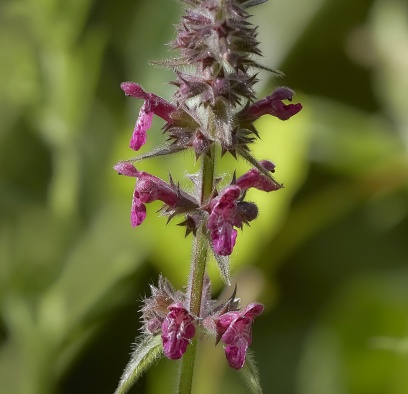
We had our coffee
break at the main seat and Derek kindly took a photo
of us all including me!
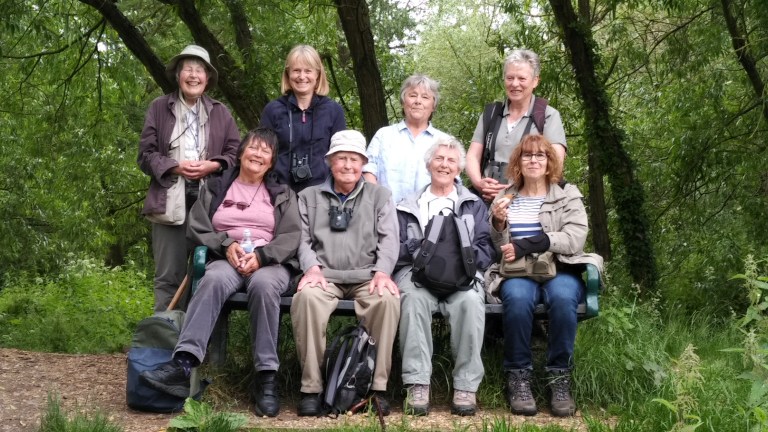
From the seat we saw a
pair of Whitethroats coming and going, collecting
grubs for nestlings. Heather got a delightful shot of
a young Whitethroat which is our first indication of
successful Whitethroat breeding this year. Brilliant.
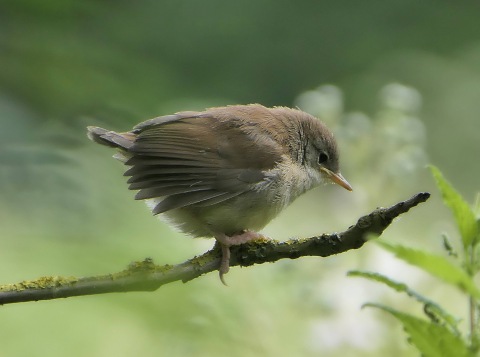
After the break I took
the group on an adventure walking through the tall
grasses on the centre meadow, where we came across two
patches of star-like Lesser Stitchwort and several
clumps of white and purple flowered Common Comfrey. We
stopped to admire the very tall spikes of Reed
Canary-grass which is the tallest grass on Brook
Meadow.
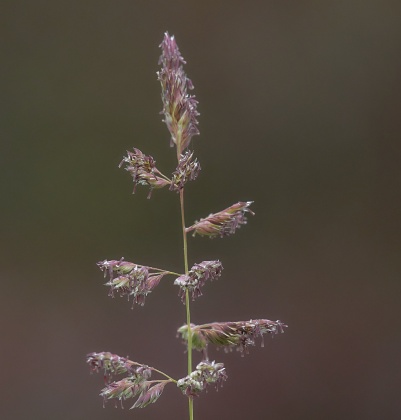
On the bird front we
were entertained in song by several Blackcaps and Song
Thrushes, the later belting out their repetitive songs
across the meadow. Chiffchaff and Whitethroat were
also heard along with Blackbird and Wren. Heather
spotted a single Swift flying over the meadow, the
first I have seen this year. Swifts are such rare
birds in this area, where they used to be fairly
common.
Regarding butterflies
we were delighted to get a good view of a Small
Tortoiseshell resting in the vegetation. We also
saw one Common Blue, a Red Admiral and several Meadow
Browns. A Cinnabar moth was spotted appropriately
close to some Hoary Ragwort plants. A Crab
Spider was caught on a Southern Marsh Orchid
Walking back along the
main river path we saw good numbers of Ladybird larvae
in various stages of development resting on nettle
leaves. It has been a good year for Ladybirds.
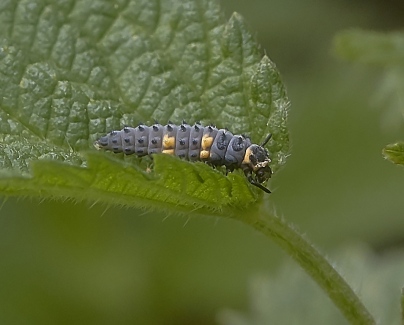
On the Lumley area I
picked a few sedges for the group to get a good look
at these underrated plants, including Distant Sedge
(Carex distans) and the nationally scarce Divided
Sedge (Carex divisa). We also stopped to admire yet
more orchids including one Bee Orchid with 8 flowers!
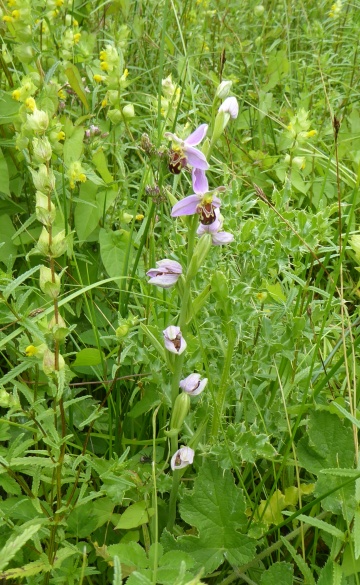
Along the small wet
path down to the Lumley Stream (where I had my last
Water Vole sighting over 2 years ago) we saw a number
of interesting plants which Ros applied her botanical
ID skills to: Celery-leaved Buttercup, Blue
Water-speedwell and Brooklime.
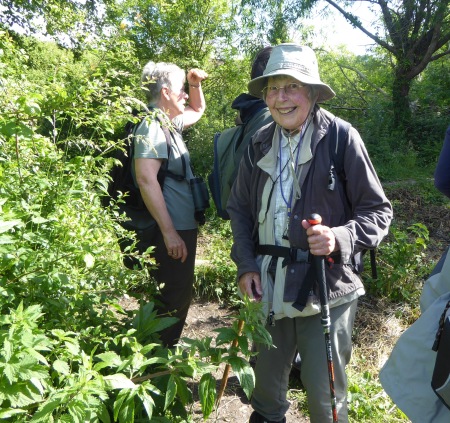
Thanks to everyone for
contributing to such an enjoyable experience.
Photos by Derek,
Heather, Sue and Brian.
SATURDAY
June 8- 2019 - Thornham to Prinsted
Fay Durant
reported on this morning's walk
Four , very brave souls , met at the junction of
Thorney Road and Thornham Lane to walk east , along
the lane and then north to Prinsted . We then
continued along the coastal path , past Thornham
Marina to Thornham point , where we cut inland to
escape the wind , and , finally ,returned down
Thornham Lane . ( The walk was curtailed due to the
weather conditions . )
We heard the very clear song of the thrush and looking
up saw a group of Canada Geese flying over us . Birds
were mainly heard , no butterflies , one small yellow
moth but what a wonderful selection of flowers .
Fortunately , Ros was with us , and she painstakingly
explained how to identify certain species . We
obtained a list of thirty eight but there were others
, not yet in flower . The mixture of red and white
valarium was most striking . At Prinstead was the
usual group of sparrows flitting around .
On the coastal path we listened to white throat and
Neill heard a reed warbler . In a small creek were
moor hens and coots and later Neill noted a shell duck
. Although distant , sky larks were heard and the
usual collection of tits and gold finch were present
in the bushes .
On the coastal path we passed a field , partly
cultivated , absolutely full of oxe- eye daisies -
what a sight to lift the spirits . Further on was a
large clump of weld , very striking and later a splash
of pink sorrel . Fortunately , prickly and smooth sow
thistle plus bristly oxtongue were growing close
together so we were able to compare .
The high light was dyers greenweed , which only occurs
in limited areas , and was used as the name implies .
It is a bright yellow and there was plenty to be seen
.Other flowers of note : red and white clover ,
mayweed , elder , dog rose , cow parsley , cut leaved
cranes bill , herb robert , common mallow , Meadow and
bulbous buttercup , creeping cinquefoil , white bryony
, hoary cress , dock , birdsfoot trefoil , common
vetch , horse radish , poppy , garlic mustard , hedge
mustard , nipplewort , ribwort plantain , shepherds
purse , honey suckle , wild carrot , and white dead
nettle , to name but a few !!!
Many thanks to my companions , who made it all
worthwhile , and a big welcome back to
Nicola
SATURDAY
June 1- 2019 - New Forest
Neill reported
on Saturday's walk by the Friends of Wildlife
group
Eight of us met at Acres Down car park on a warm,
sunny morning with not much breeze.
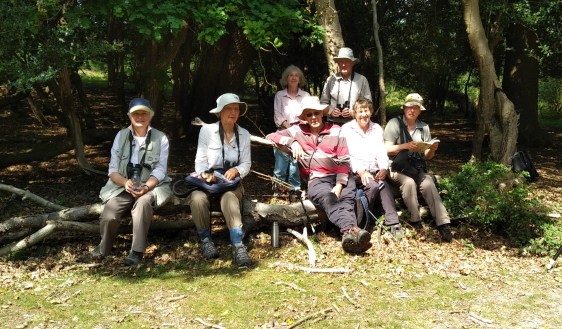
Unusually there was
little bird song here, mainly Chaffinch and Great Tit.
A Blue Tit was feeding young and a Coal Tit was
foraging in the trees. As we set off there was
Squinancywort under foot, a Harlequin ladybird was
found close to other native species. Willow Warbler
and Robin were singing.
Along the ridge we heard a Cuckoo and found male and
female Stonechats with young, Song Thrush, Greenfinch,
more Chaffinch, and Linnets. Ground-feeding pipits
were considered to be Tree Pipit. The only raptors
seen were common Buzzards.
In the boggy area we found Lousewort, Pale Butterwort,
Common Round-leaved Sundew, Southern Marsh Orchid and
Knapweed.
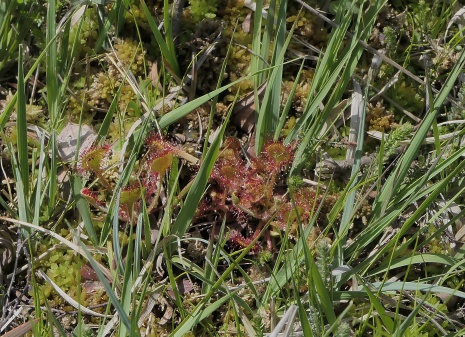
Whilst we watched an
(unidentified) grasshopper, two of what were either
lizards or newts scurried away but again they were too
quick for us to identify. Up through the woods the
ponies kept their foals in the shade and there were
several singing Wrens. Altogether, an unusually
uneventful morning.
After lunch we moved to Shatterford, near Beaulieu
Road Station. Overhead, as we set off, some House
Martins were feeding, while others collected insects
from the distant pond and returned to the houses,
presumably still feeding young. Near the railway
bridge we watched for some time another ground-feeding
pipit that did not appear to be a meadow but again we
were unable positively identify it as a Tree Pipit
(but see later). At the ponds, insects included
Dragonfly hawkers, Common Blue Damselflies, mating
Broad-bodied Chasers and Brimstone butterflies. A Jay
and a Curlew flew across and a couple of Reed Buntings
were present.
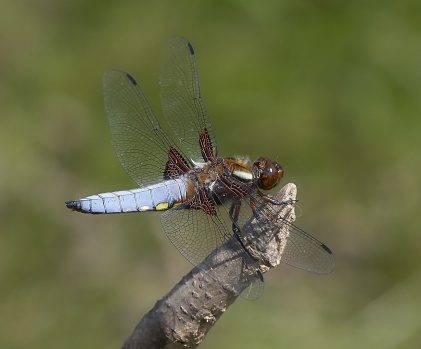
As we entered the edge
of the woodland we stopped to watch male and female
Redstarts, and then Spotted Flycatchers. Moments later
two Treecreepers appeared on the broad trunk of an old
oak tree and proceeded to chase each other around the
trunk. A Cuckoo could be heard calling.
Then followed the most
extraordinary event of the day as we tried to identify
what we took to be two small birds with a curious
bat-like flight about ten feet up amongst the tree
trunks. It took a few seconds for us to realise that
these were not birds at all and that they were indeed
bats - flying around in broad daylight at three
o'clock on a warm summer afternoon! When settled,
clinging to the bark of the tree trunk, they could be
studied in detail. The body was light brown and the
large ears, of a length greater than half the body
length, appeared translucent pink (see Derek's
incredible photos). We agreed the species as
Long-eared Bat, and that we would never have a better
sighting!
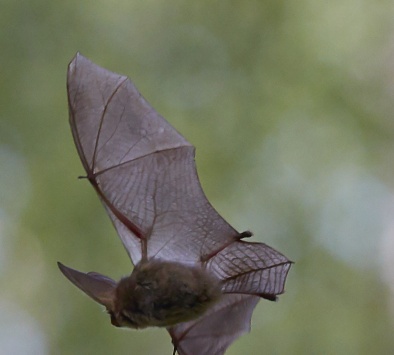
Further along the
track we inspected the Hornets nest in the poor old
oak tree, where it has been for decades. The lake held
only a couple of Canada Geese and a solitary Lapwing.
A Great Spotted Woodpecker was nearby and a single,
very smart, Pied Wagtail fed on the ground at the edge
of the woodland.
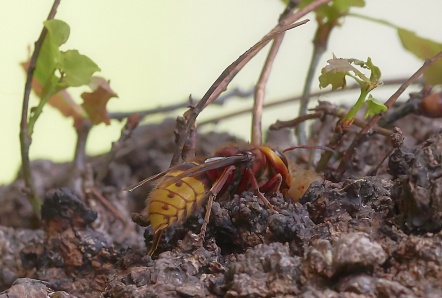
Other butterflies
noted were Large White, Small Heath, and Red Admiral.
Other plants noted were Round-leaved Water Crowfoot,
Coral Necklace (later identified by Heather as being
found mainly in the NF), Lesser Spearwort and
Milkwort, Foxgloves, Bell Heather, Bilberry,
Tormentil, Gorse.
Heather and Derek stayed on for a little longer. They
watched Coal Tit feeding a juvenile in the Scots
pines. They then took another leisurely walk to the
bottom where they had a view of the Willow warbler
briefly and saw maybe the same pair of Redstart with
another through the woods, walking east. A pair of
Bullfinch came into a Hawthorn late on and a busy
Treecreeper going into it's crevice in a tree. A
Woodpecker flew off as they ambled through. A herd of
8 Fallow deer were over in the distance. On returning
they got better views of the Tree Pipit which did what
it says in the books: sang from a tree top. The Cuckoo
was calling this time from the east.
Grateful thanks to Heather for supplying the plant
list and confirming some difficult identifications,
and to Derek for a great set of photos.
SATURDAY
MAY 25 - 2019 - Kingley Vale
Heather Mills
reported on this morning's walk by the Friends of
Wildlife group.
Six met this morning on a bright morning to search out
the delights of Kingley Vale. Our first encounter was
a singing Yellowhammer with a nearby Common
Whitethroat and singing Chaffinch. We were fortunate
to find a Wren with its juveniles in the hedgerow
calling to be fed. We stopped at a hedge line in the
field to locate another calling Yellowhammer. Before
we had located it Neill saw a female Blackcap dive
into the bushes and luckily this was followed by the
Male which most of us saw. A Dunnock sang on top of
the bush as we found the Yellowhammer had come much
closer.
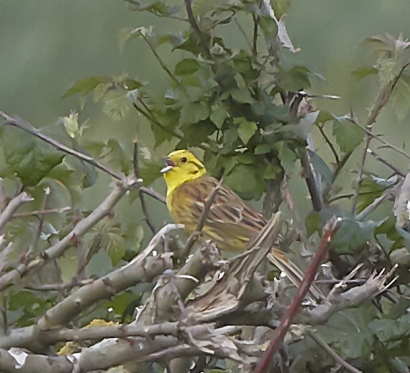
A large number of
Ladybirds had appeared along the footpath together
with a couple of Small White butterflies and Red
Admirals together with a few Brimstone males and
females and Orange Tip butterflies.
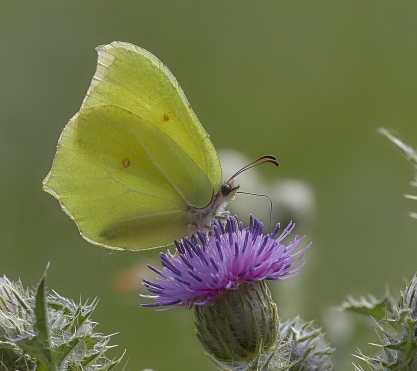
Further along the
White Campion was abundant with a few Red dotted
about, and a good display of White Bryony and
Cut-leaved Cranesbill. Ros also identified Lesser
Stitchwort.
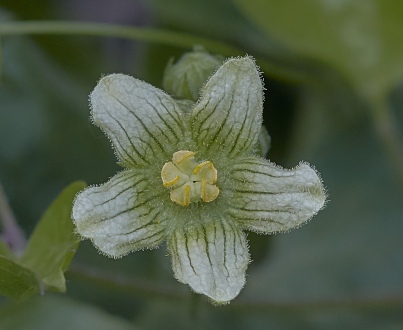
As we proceeded along
the main footpath into the reserve Blackcaps
constantly accompanied us with their singing right
into the reserve entrance.
Stephanie had visited
recently and hoped to be able to show us the
Grizzled skippers. Right on cue a few flew up
and we also had Dingy Skipper and Common Blue
with a Small Copper.
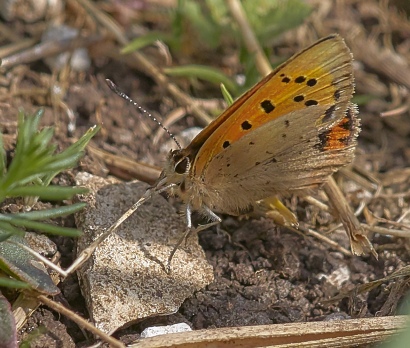
Bullfinch called and
Goldcrest sang with more Yellowhammers as we
progressed. A wonderful sight of a Whitebeam in
glorious blossom attracted a myriad of Red Admirals
and humming bees. A few Yellow Shell Moths flew around
too.
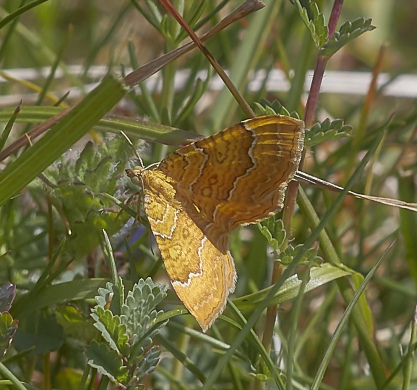
We stopped for coffee
after having inspected the dew pond which
unfortunately had dried up. The most exciting event
was a singing Turtle Dove. We were all thrilled
to hear it. As we returned through the Yew trees a
family of Treecreepers suddenly searched the
trunks for insects. A sight for sore eyes to see these
endearing birds doing well.
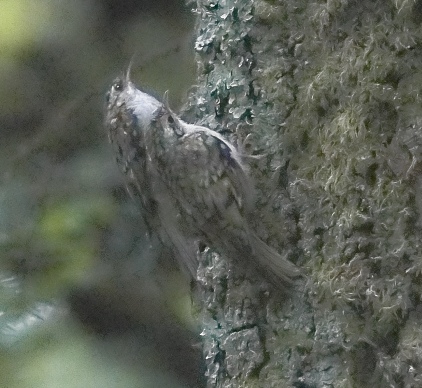
Ros pointed out the
Marsh Thistles and I captured a close one but I now
think this is Woolly Thistle.
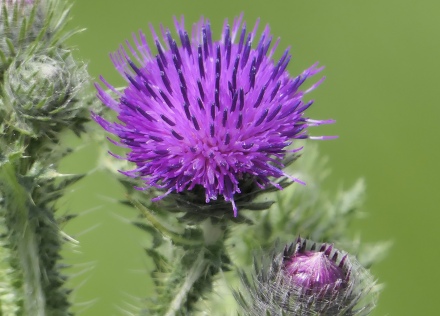
A very pleasant
morning with wonderful surprises.
SATURDAY
MAY 18 - 2019 - SW Hayling
Ros Norton
reported on this morning's walk.
A group of 9 started from the Gunsite lay by and
walked a clockwise circuit of Gunner Point, Golf
Course and Ferry area on a cloudy but calm morning.
Common storksbill was growing in the adjacent field.
West of the golf course we found round leaved
cranesbill, tree mallow, hoary cress , some unusual
groundsel and lots of thrift. Bur chervil flowers were
almost over.
Walking west along the
beach the Sea radish, sea kale and tree lupin flowers
were spectacular.
Notices indicated that
ringed plovers were likely to nest on the beach and a
big area had been fenced off . This prevented us
looking for the rare little robin plants. A skylark
landed in the fenced area. There were whitethroats,
greenfinches, chaffinches, chiffchaffs, swallows, and
a sandwich tern seen or heard during the walk. A
little egret and oystercatcher were around the lake by
Ferry Road near the Kench.
The green winged
orchids were still in flower after about a month but
the Nottingham Catchfly is only in bud. Spring Beauty
is over but sea sandwort is in flower. Along Ferry
Road we saw spotted medick, hop trefoil, green
alkanet, ramping fumitory, a tall spindle shrub
covered in flowers and Tartar honeysuckle. There were
many other plants in flower including harestail grass,
birdsfoot trefoil, sea campion, cats ear, mouse ear
hawkweed, beaked hawksbeard, smooth sow thistle,
yellow rattle, sheeps sorrel, bittersweet, and
buckshorn plantain.
sea sandwort . .
. . ramping fumitory . . . harestail grass
A few white
butterflies, bumblebees and aphids were among the
insects seen. A vole emerged from the undergrowth.
It was a good time of year to visit this
area.
SATURDAY
MAY 11 - 2019 - Petersfield Heath and Lake
Valerie
Mitchell reported on this morning's walk
Six of us met on a fine chilly morning
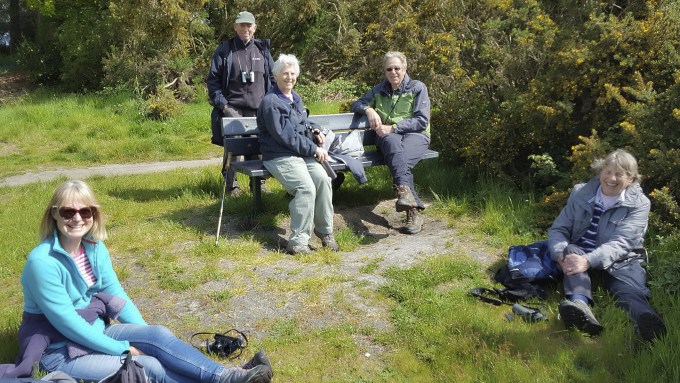
The sight of many
ancient majestic oak and Scot's pine trees in full
leave confirmed that Spring was definitely here.
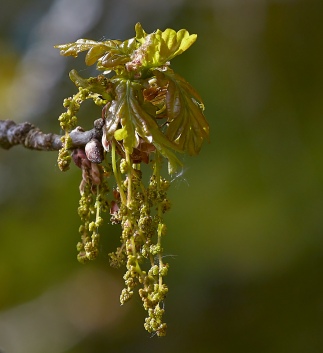
We walked away from
the car park and the Lake, through the Heath and
woodland around this complex Bronze Age Burial site,
before walking along the West side of the Lake.
Birds could be heard singing in the trees, but were
difficult to locate in all the fresh foliage, blackcap
and wren could be heard.
A gold crest was spotted in a Scot's pine. Bright
yellow flowers of broom were compared to the lesser
yellow of the gorse bushes, and mountain ash was in
full bloom.
A family of long tail tits were heard, then finally
seen feeding their babies up in the trees, a nuthatch
was also spotted feeding its young. A mistle thrush
was clearly seen on the cricket pitch busy collecting
worms for it's young, high up in a tree nearby, it
made several journeys.
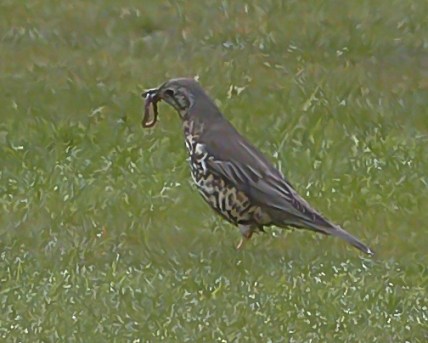
Finally the sun came
out, swallows, swifts and house martins were seen
flying around catching insects. Two buzzards were
being hassled by a couple of crows.
In the sedges along the edge of the pond, willow
warblers were seen alongside sparrows, baby coots and
moorhens were feeding in the shallows.
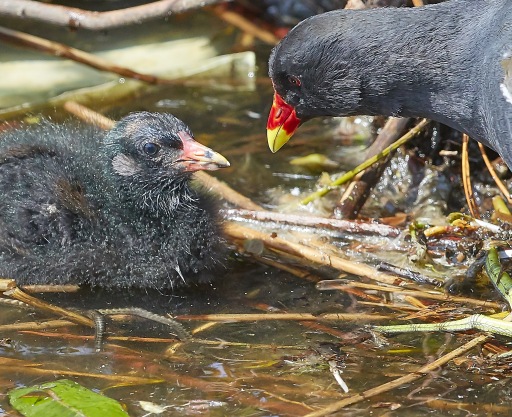
Black headed gulls,
herring gull, black swan and a swan sitting on its
nest, were also spotted on the Lake.
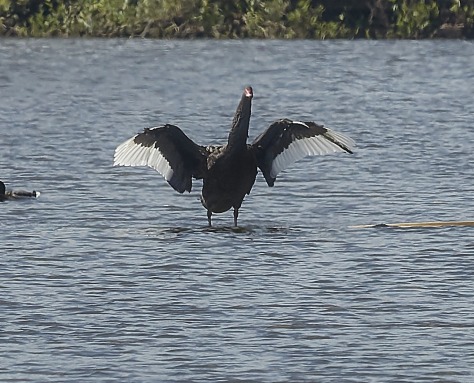
On returning to the
car park Val spotted a butterfly, that suddenly
disappeared, it had landed on Steph's back, a speckled
wood.
There was plenty of nettles, Green alkanet with its
bright blue flowers, shepherd's purse, tormentil,
sheep's sorrel, cut leaved cranesbill ,
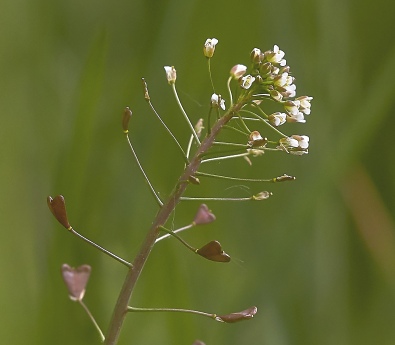
Fungus seen on the
piles of wood chippings were not identified. Heather
says the one on the right is a slime mould.
A lovely relaxing
Spring walk.
SATURDAY
MAY 4 - 2019 - Portchester
Fay Durant
reports on the walk
Four hardy souls met at the Portchester Castle car
park on a sunny but cold morning , due to a strong
wind from the north . We walked round the shore line ,
north , then back through the trees , round the edge
of Castle field for coffee , in the shadow of the
castle , then we walked south west , returning down
Hospital Lane .
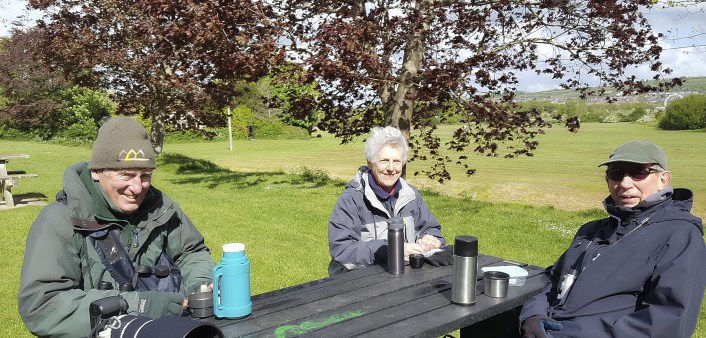
We noted a little
egret on the field , then whimbrel , curlew , oyster
catchers , two lesser black backed gulls and , the
high light , a pair of swans with four very young pale
grey cygnets , near a water outlet .
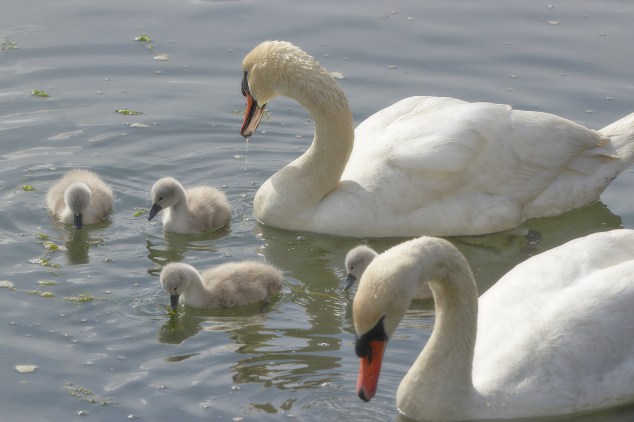
Later , a couple of
common terns flew overhead .We spent some time
studying the various trees in flower and decided on
sycamore and sweet chestnut , with Nicola's help !
Numerous white poplar made a striking backdrop . A
great variety of flowers were seen : swathes of
Alexanders , Portsmouth weed ( hoarycress ) and cow
parsley + herb robert , bush vetch , dove's foot
crane's bill , common stork's bill , bulbous buttercup
, meadow buttercup , woody nightshade .
Walking round the
castle walls we saw the famous yellow wallflowers and
valerian , growing amongst the castle stones . High up
, in holes in the wall , were starlings' nests and we
watched the parents feeding the young .
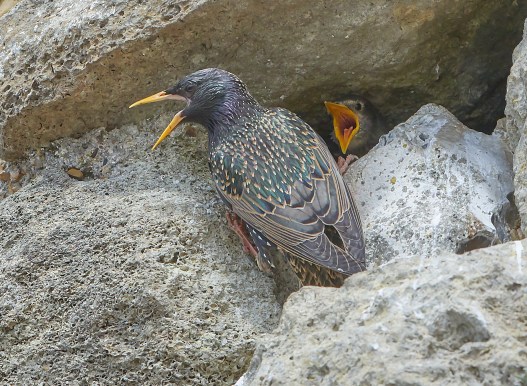
A pair of rock dove /
pigeons flew down , identical in markings . Further
round , we were amused by the antics of a great tit ,
using a very old post box to feed its young .
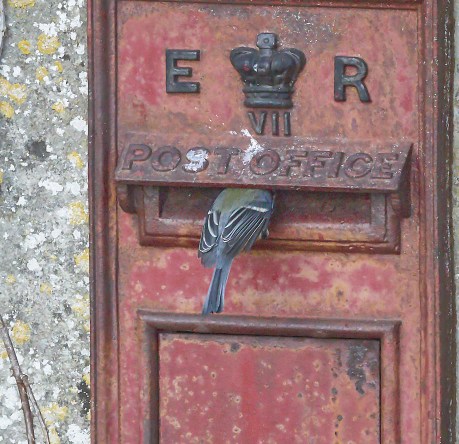
On the way we passed a
field full of crows , quite menacing ! Along the edge
were attractive bushes of tamarisk and buckthorn - a
delightful splash of pink .Returning up Hospital Lane
we noted more flowers : numerous three cornered leeks
, under the trees , green alkanet , many white plants
of comfrey , smooth sow thistle , garlic mustard ,
groundsel , white and red dead nettle , lords and
ladies .
There were plenty of gold finch around , blackbirds ,
tits and considerable time was spent listening to a
lesser white throat but not seen , also blackcap ,
chaffinch , wren , dunnock , chiffchaff and good views
of robins .It proved a very productive morning and not
uncomfortably cold . Thanks to those that turned up
and provided the expertise .
SATURDAY
APRIL 27 - 2019 - Pulborough Brooks
Neil reported
on this mornings walk
At this time of year, Pulborough Brooks is a regarded
as a nightingale hot-spot and today, despite the
strong breeze, it did not disappoint our group of
five. We were lucky to find our target species at no
less than three locations around the reserve and
listened with delight to their songs from only a few
metres away. We even managed sightings as they flitted
through the bushes. Other warblers seen and heard
around the trail were chiffchaff (many), lesser
whitethroat (many), blackcap (many) and common
whitethroat.
Behind the visitor
centre Heather found three stock doves and a moorhen
with three well-grown young. Along the path to
Fattengates were a red-legged partridge
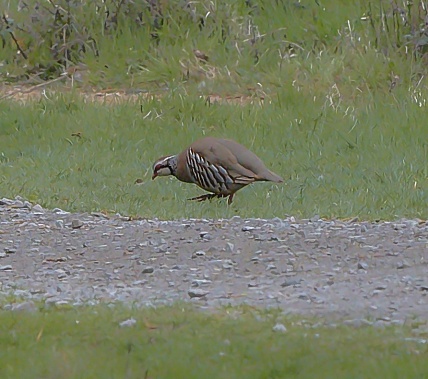
Also a song thrush, a
smart male bullfinch, an equally smart male kestrel
(being mobbed by a magpie),
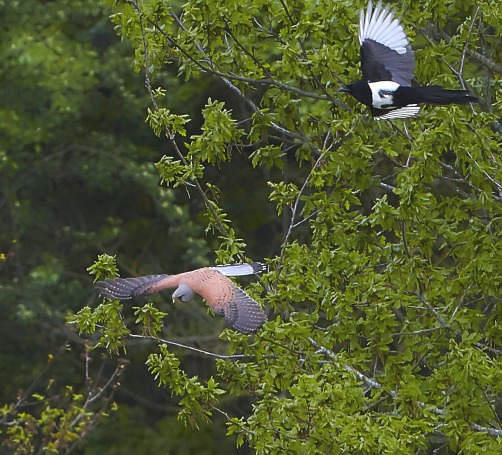
and a lesser
whitethroat that showed well enough for Derek to
photograph
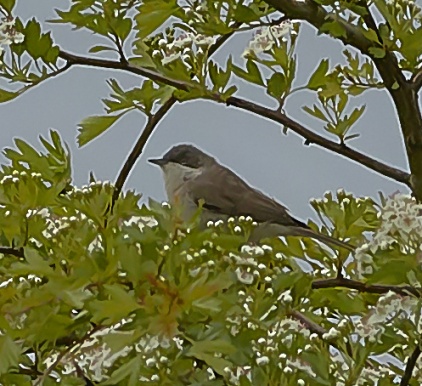
A distant cuckoo was
calling. From West Mead Hide were seen mallard, shell
duck, Canada geese, pheasant and coot.
Further along the trail, close to one of the
nightingales, Jill spotted a smart male reed
bunting.
From Winpenny Hide we saw a little egret, a single
common redshank, mute swans, skylarks, a pair of
gadwall, moorhen, swallows and house martins. We found
one lapwing that had three small chicks running about,
which the official lapwing recorder in the hide was
pleased to log down. An Egyptian goose also had three
young.
From Hangar View there was a lovely male linnet, later
to be joined by more. There were blackcap, chaffinch,
chiffchaff, common whitethroat, grey heron, a flock of
teal, a single avocet, two more Egyptian geese, and a
single sand martin spotted by heather amongst the
other hirundines. A pair of lesser black-backed gulls
sat amongst the herring gulls on the ground. A perched
raptor was assumed to be a common buzzard despite
unusually pale under-body plumage.
Along the track back to the visitor centre we heard a
greenfinch and saw some long-tailed tits.
Mammals seen were a brown rat, two roe deer, and many
rabbits.
Wild flowers included Greater Stitchwort, Primrose,
Bluebell, Common Dog Violet, Lesser Celandine, Ground
Ivy and Bugle.
SATURDAY
APRIL 13 - 2019 - Chichester Marina
Steph Dale
reported on this morning's walk. Nine of us gathered
at Chichester Marina on a sunny but quite a cold
morning.
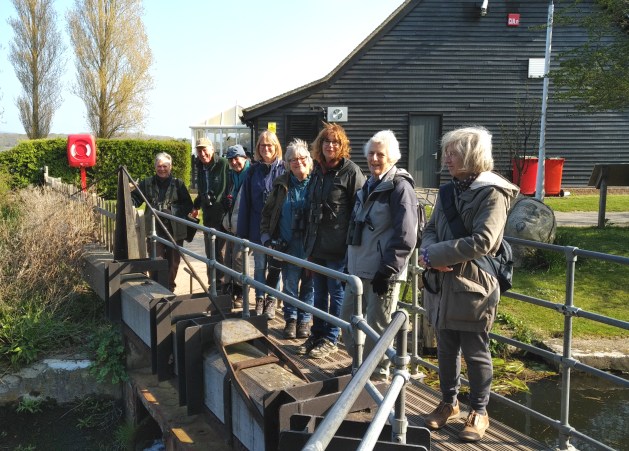
We set off walking
along the northern edge of the marina and noticed two
robins on the ground having a standoff with their
tails held high. In the area of the reed beds we heard
and then saw a Cetti's warbler and also a reed
bunting.
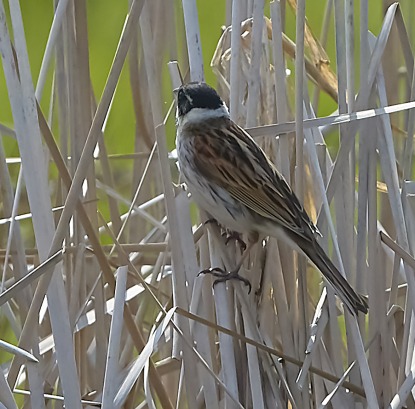
Chaffinches, dunnocks,
great tits, goldfinches and a buzzard were
spotted.
We stood at the western end of the marina looking
towards the channel and were delighted to see a large
number of black-tailed godwits feeding, all in
beautiful summer plumage.
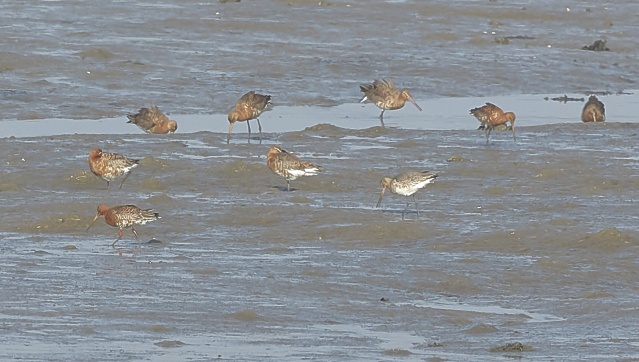
Also seen at this
stage were shelduck, curlews, an oystercatcher, a
cormorant, a little egret, swans and great crested
grebes. We saw three swallows and some sandwich terns
flying over and two of the terns settled on a yellow
buoy for some courting - a lovely sight.
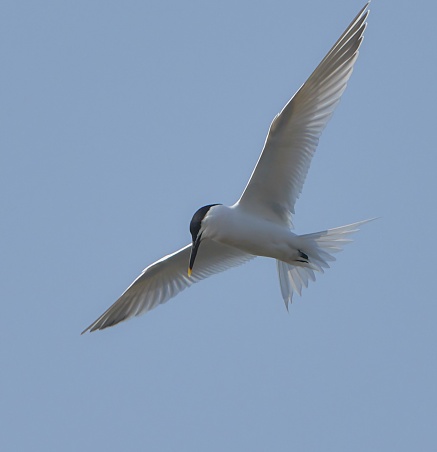
We then crossed over
the lock and headed towards Birdham Pool. On the way
we enjoyed seeing primroses, sweet violets, bluebells,
herb Robert, greater stitchwort and ground ivy. At the
pool we had good close views of two great crested
grebes; also a little grebe, shelduck, teal and
gadwall. Mediterranean gulls flew over.
We stopped for a
coffee break in a sunlit glade next to the pool and
then walked back towards the marina to walk east along
the canal. More flowers were seen - garlic mustard,
some cow parsley just about to come out, celandines,
red and white dead nettles, green alkanet, gorse,
cuckoo flowers and black mustard - and more birds -
house sparrows, a wren and a greenfinch
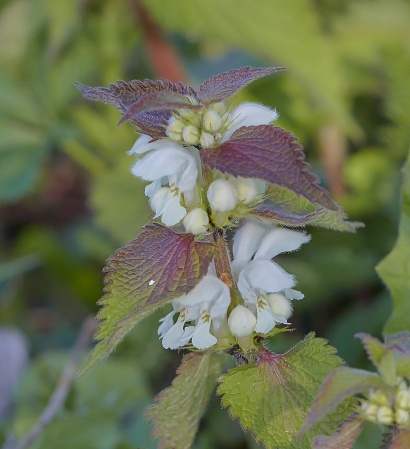
On the canal we saw
coots with young chicks, a coot sitting on a nest,
tufted ducks, moorhens and a very friendly black swan.
The first Coot
chick of the year?
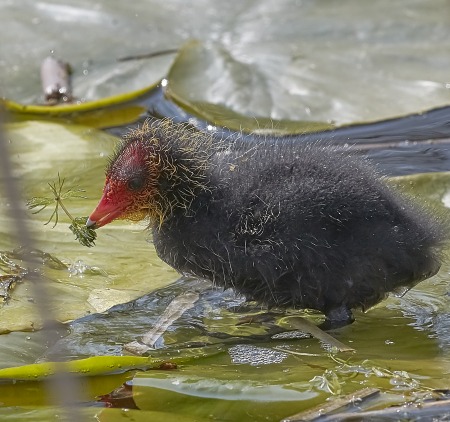
We had good views of
several more reed buntings. There was a lot of hemlock
water dropwort but it was not in flower; also horse
tails were just coming up and we saw a dock growing in
the canal so this may have been water dock.
On the south side of
the canal was a field of sheep and lambs and we
noticed a dead ewe on her back with her legs in the
air; her two lambs were nearby. As it happened, there
were two men walking along the far side of the field,
carrying a dead lamb, but they had not noticed the ewe
so we all shouted and pointed to draw their attention
to it. As they approached, the ewe started moving (it
was alive after all!) and it was happy to be turned
the right way up by the farmers. We were all delighted
too.
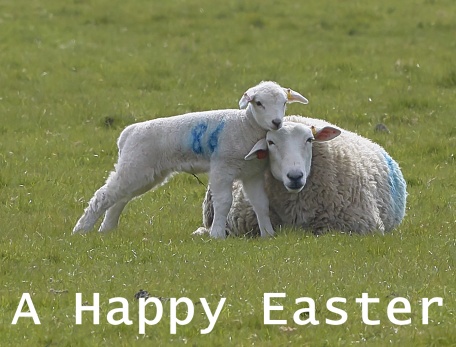
Before heading back to
the cars we had a good view of a great spotted
woodpecker and heard a black cap.
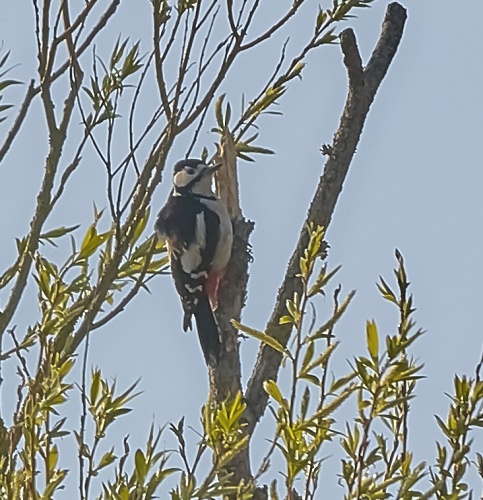
Thank you all for your
company and thank you, Heather, for bringing your
telescope and sharing it with us all.
Lilac Beauty Moth
from Heather
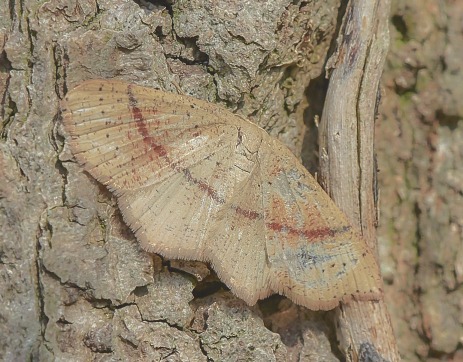
SATURDAY
April 6 - 2019 - Testwood Lakes
Valerie
Mitchell reported on this morning's walk
10 of us met at Testwood Lakes on a chilly, slightly
hazy morning. A decision was made not to visit Little
Testwood Lake, but to walk south of the large lake,
where we watched several crested grebes performing
courtship displays, but not yet offering weed !
Blackcap and chiff chaff were seen in the car park.
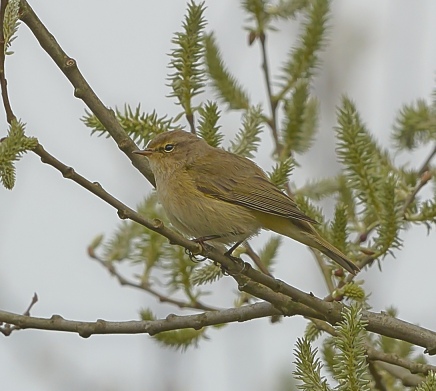
Everything seemed very
quiet, few people and birds, but lovely fresh leaves
of hazelnut, hawthorn, blossoms of blackthorn and
catkins appearing on the trees, reminded us that
Spring had sprung. A great spotted woodpecker was
seen, cettis were heard.
We made our way to the
Sand Piper Hide and enjoyed the antics of hundreds of
sand martins flying close to the water surface and
returning to their nests in the sand martin wall,
which has recently been extended.
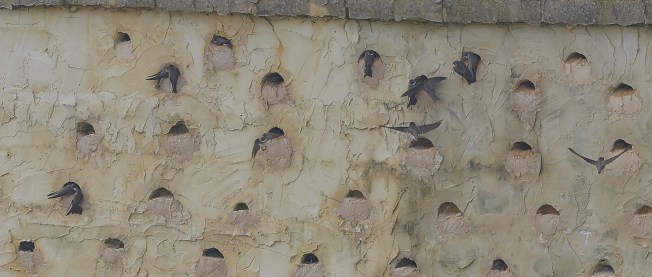
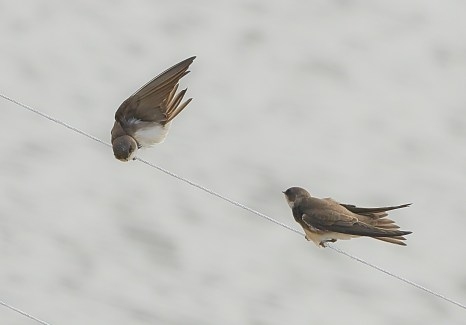
At the far end stood a
lone great white egret, who even yawned while standing
there.
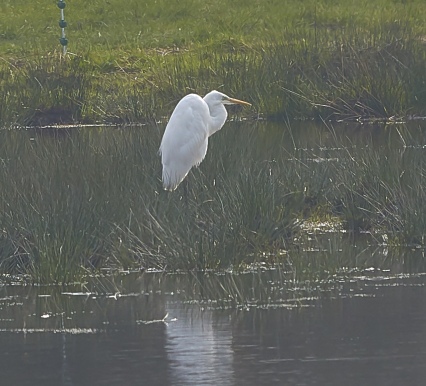
Other birds spotted on
the lake were heron, cormorant, tufted ducks, a lone
canada goose. We saw swallow, house martin, buzzard.
Three roe deer were resting on the far shore. The Sun
came out, which pleased us all, especially the
photographers.
We carried on North to
the Heron Hide, overlooking Meadow Lake, cormorants,
herons, coots, tufted ducks, mallards were seen. On
leaving the hide we watched a kestrel hovering very
close to us (see Derek's lovely photo).
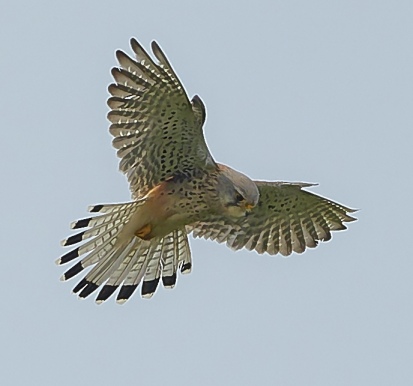
We returned through
woodland going east, seeing gold crest, finches,
nuthatch, robin, wren, blackbirds and great tits,
after walking along the other side on this narrow
gulley we then visited the Scrapes, looking thro the
narrow slots in the wooden fence, Heather instantly
spotted a wheatear sitting in the middle of one of the
3 islands, widgeon, teal, lapwing were also seen.
Our return path, running parallel to the River
Blackwater, was flooded in places. The River Test
actually runs parallel to the Blackwater, about 200m
North, apologies for my wrong information.
Plants were moscatel
(5 faced bishop/ townhall clock), kingcups, figwort
(no flowers), yellow pimpernel, red nettle,
dandelions, celandine, primroses, bluebells, wild
strawberries, violets.
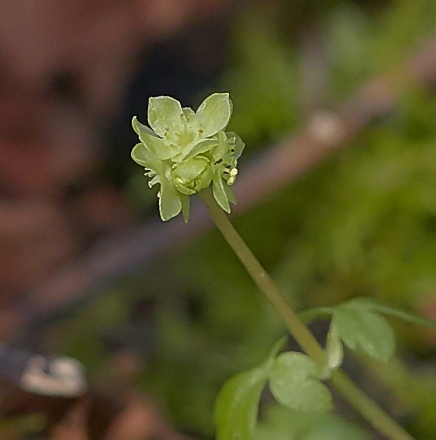
No brimstones were
spotted, but orange tip, red admiral, speckled wood
butterflies were seen, also ladybirds, hoverflies and
different bees. Despite a quiet, hazy start to the
day, we all had an enjoyable time, the highlight,
seeing the very active sand martins. Hope our friends
who were unable to come on this walk will enjoy this
report and Derek's photos.
SATURDAY
MARCH 30 - 2019 - Farlington Marshes
Helen Penfold
reports on the morning walk Seven of us enjoyed a
sunny walk around Farlington marshes.
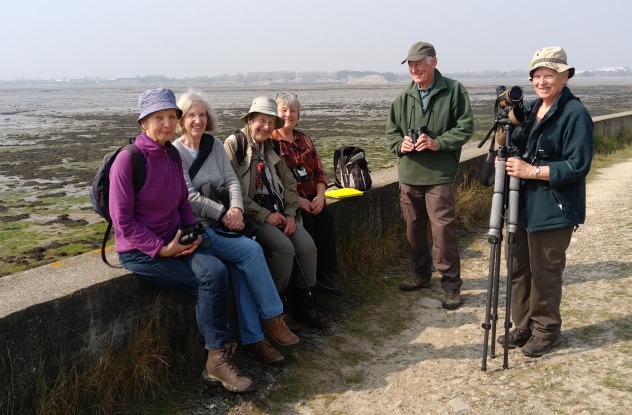
The morning started
well with Heather locating seals far out to sea.
Cetti warblers and green finches 'sang ' to us
through out the morning. Derek got a nice shot of a
Cetti's Warbler on previous outing last
Thursday.
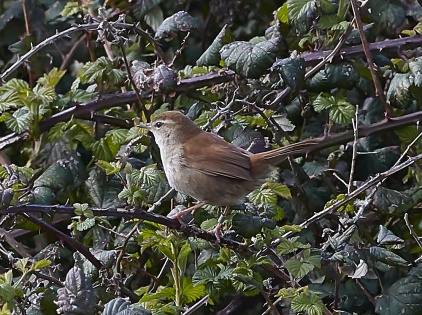
We had fine views of
two linnets building a nest, and later of two
skylarks.
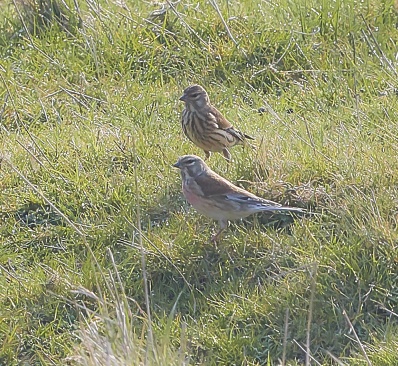
At the far end of the
first lake there was a large flock of red shanks with
a few dunlin among them, black tailed godwits, some of
which had their lovely summer plumage, a lone avocet
and a grey plover. Several snipe were hiding in the
reeds. Teal, coots and moorhens were on the water.
There were Brent geese and Canada geese in the fields
and a few mute swans. On the seaward side a curlew
pottered in the mud.
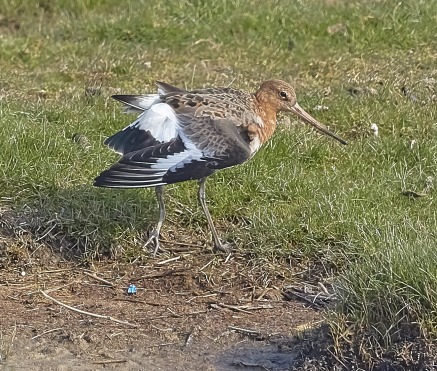
As we drank our
coffee, enjoying the sunshine, a marsh harrier flew
overhead.
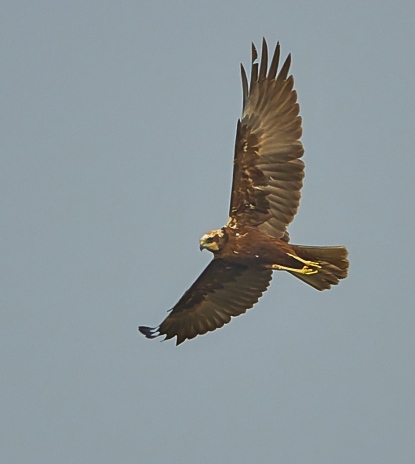
At the next inland
lake ducks seen included shovelers, wigeon, tufted
duck shelduck, mallards and teal. Lapwing flew in the
field beyond. During the morning we also had fine
views of a peregrine falcon, several kestrels, two
little grebe, a wheatear, wrens and several meadow
pipits. Walking back from the hut through the fields,
we heard a back cap singing and saw great tits,
goldfinches, robins and black birds.
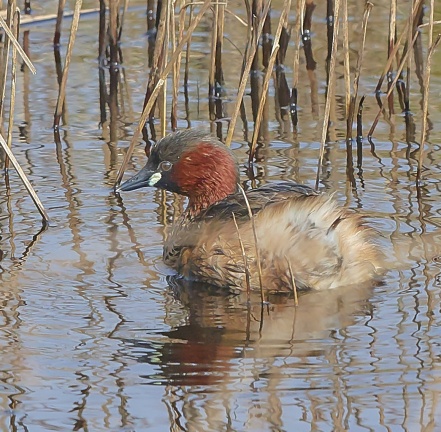
The sun brought out
the Brimstone butterflies, several whites and a
peacock. A crew rabbits hopped about in the fields and
flowers seen included Alexanders, Oxford ragwort,
black mustard and dandelions.
SATURDAY
MARCH 23 - 2019 - Alver Valley Wildgrounds
Tony Wootton
reported on this morning's walk
Today 9 of us had a pleasant and interesting walk
around this site near Gosport. It was mainly grey,
still and dry.
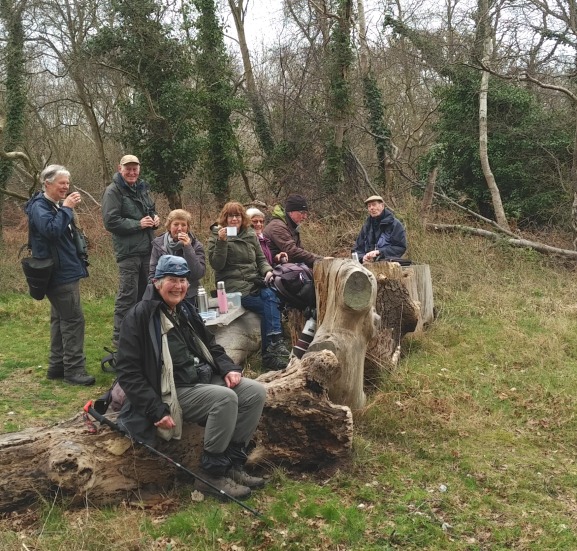
I would ask everyone
to remember for next time that the gate to the
wildgrounds has moved to the car park which we are
more familiar with, namely the 17th century village
car park with radar toilets. The gates don't open
until 10.00 and the charge for seniors is
£1.50.
The highlights for me were being greeted by 3 great
spotted woodpeckers chasing each other, a buzzard
seeing off a crow for once , the strong possibility of
hearing a lesser spotted woodpecker, watching a pair
of nuthatches going in and out of a tree hole and
finally, right at the end when the sun came out, 3
male brimstones.
Other birds seen were
gadwall, mallard, grey heron, kestrel, moorhen, coot,
blackheaded gull, herring gull, wood pigeon,
kingfisher, green woodpecker, pied wagtail, wren,
dunnock, robin, blackbird, mistle thrush, longtail,
blue, great and coal tits, magpie, jackdaw, carrion
crow, green finch, and gold finch.
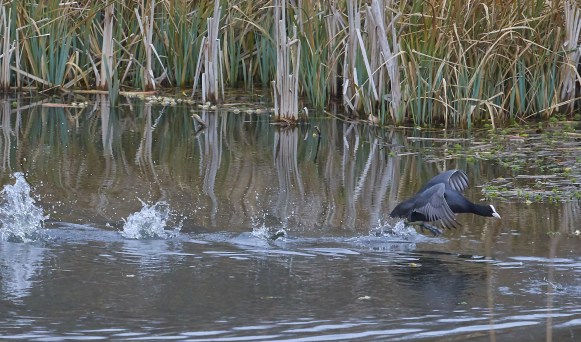
We also saw a small
tortoiseshell, primrose, greater stitchwort,
bittercress, celandine and climbing
corydalis.
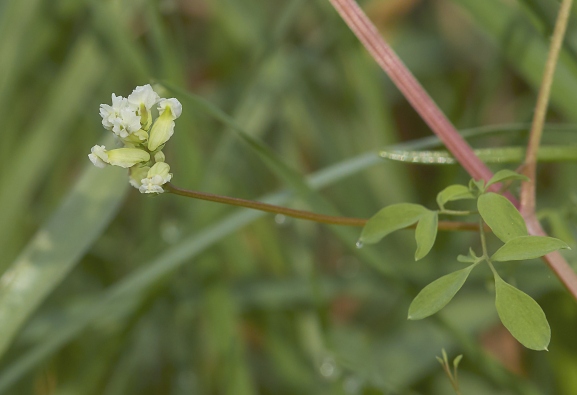
SATURDAY
MARCH 9 - 2019 - Langstone - Warblington
Heather Mills
reports on this morning's walk
On a very blustery morning with a westerly in full
force, 8 met at The Ship and braved the weather to
enjoy a few birding spectacles. As the wind whipped up
the yacht masts into playing out their high pitched
whistling tunes, we set off towards the millpond. We
had really close views of a ringed Greenshank
who alighted along the freshly uncovered shoreline to
feed avidly. Rings were blue over red right tibia leg
and lower tarsus also had a silver ring. Left leg
green on tibia over red on tarsus.
Note
on the colour-ringed Greenshank from Brian
Here is a photo of the Greenshank showing the rings
taken at the same place by Christopher Evans today. I
think this was one of the 13 Greenshank caught and
ringed by Pete Potts and his team at Thorney Deeps in
Jan 2014. Since then it has been regularly recorded at
Langstone most recently by Peter Milinets-Raby on
09-Feb-19.
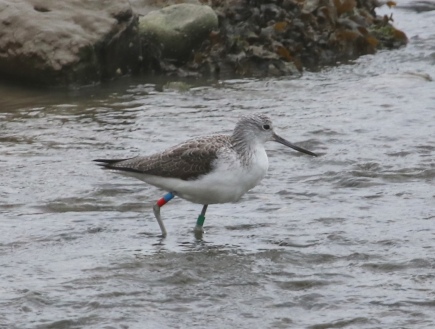
A flock of over 30
Black-tailed Godwits also fed near by. One or two
already showing their amazing summer plumage.
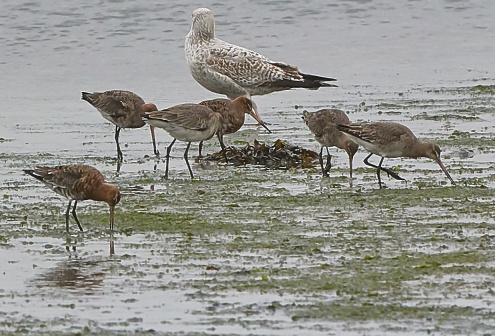
We noted at least 4
diving Mergansers further out in the channel. After a
slight detour due to repairs at the mill on the
footpath side, we had very few birds on the pond
probably due to the workmen close by. The usual Coots,
Mallards and Moorhens dabbled along with a Mute swan
and a couple of Teal with a Stock and Collared dove
also seen. I heard a Chiffchaff call and we were lucky
enough to see it eagerly hunting for insects at the
base of one of the trees. It gave a smattering of song
later.
A Grey Heron flew off from the trees where Little
Egrets and Herons bred last year. As we continued 5
Herons gathered in the field in front of Wade court,
with a few Little Egrets and Wigeon. Nicola was quick
to spot a Green woodpecker. As we descended onto the
beach a few Brent dabbled on the edge of the outgoing
tide and 3 Curlew also picked on the newly uncovered
mud. A few Oystercatchers and Redshank were just about
visible in the vegetation.
We headed through the field looking for any Cattle
Egrets but could only see Little Egrets in the
distance. Fine rain made identification tricky without
a scope. After a welcome break in the churchyard
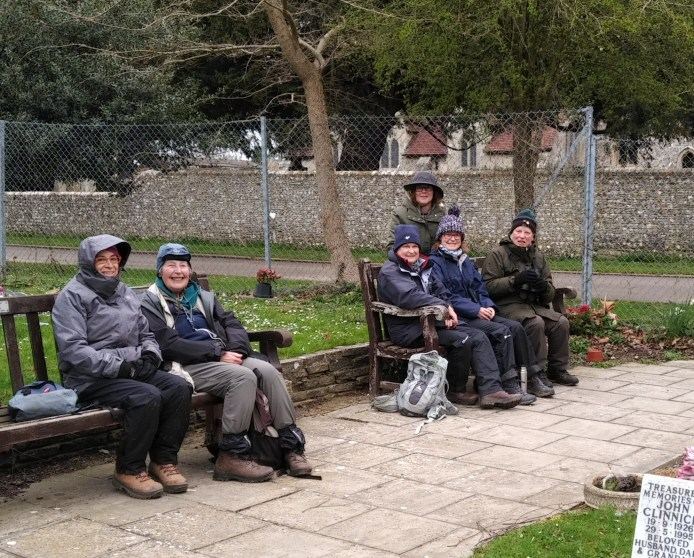
we set off to try
again for the Cattle Egrets. We did manage 1 a long
way off but behind one of the cows at the top of the
field. At least 20 Little Egrets settled in this field
with numerous Black-headed Gulls. We were lucky to
find 2 Common and Lesser Black-back gulls in front of
the Mill as we returned with 2 Med Gulls showing their
fine black heads. Plants noted making a splash of
colour in the lane Sweet violets and a good showing of
Lesser Celandine.
SATURDAY
MARCH 9 - 2019 - Thornham Lane
Nicola Hammond
reports on this morning's walk:
Eight met at Thornham Lane on a very blustery morning.
From the parked cars we viewed a kestrel skimming
across the field. We walked along the footpath passed
the stables where there were large patches of sweet
violets. Onward to the seawall for a brief look over
the harbour where Brent geese and a large group of
mixed gulls were sheltering in the corner, with a few
oystercatchers on the shoreline. Overhead we heard the
call of the mediterranean gulls. Walking to the deeps
we stopped to admire a tree full of white blossom,
which we believed to be a type of cherry plum.
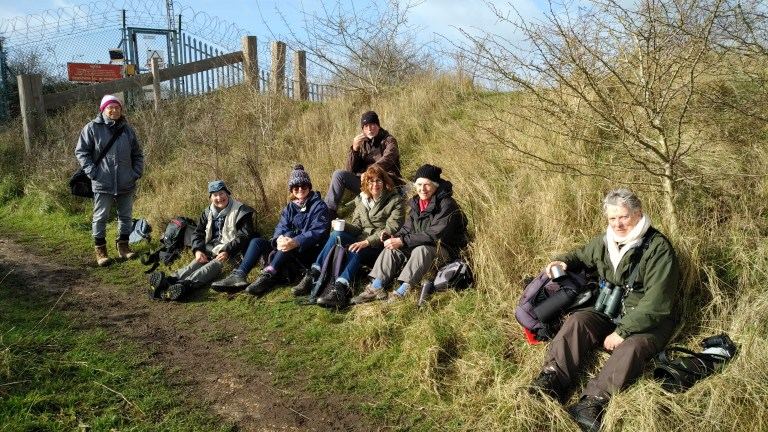
Views over the deeps
were quite difficult with the sun in our eyes but we
could identify Canada geese, tufted duck, teal and
mallards. A lone curlew was seen plus a little egret,
a little grebe and a great crested grebe which gave us
good views.
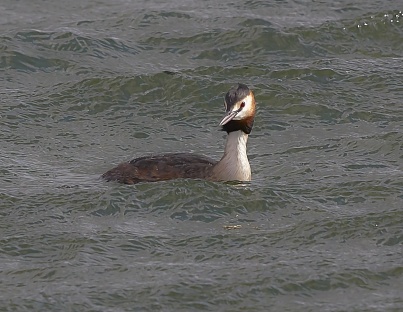
Skylarks were numerous
and in full song and a pipit was heard. Coltsfoot was
coming into bloom and some saw a red admiral
butterfly.
We then headed for the shelter of Thornham Lane where
almost immediately we were greeted by the loud shouts
of two Cettis warblers. We stood and listened to their
calls, mingled with the songs from greenfinches and
chaffinch. We had brief views of long tailed tits and
blue tits. The lane was lined with lush alexanders and
there were more sweet violets, lesser celandine and
red dead nettle.
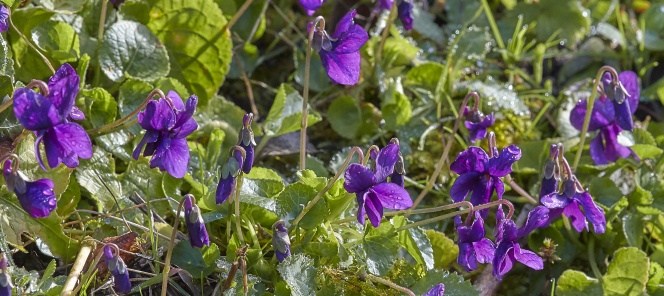
We spotted three
fungii on a pile of manure, which Heather later
identified as Panelous semiovatus.
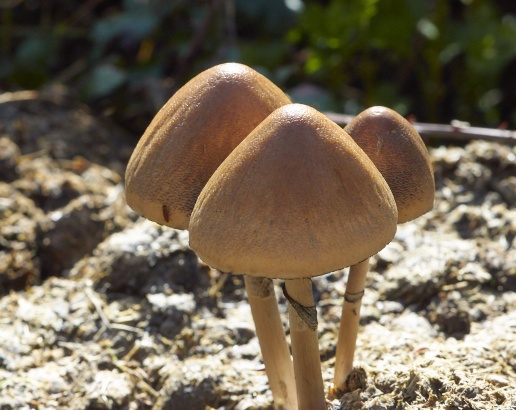
Some caught sight of a
Brimstone and we all finally had close views of a
lizard basking in a sheltered spot.
SATURDAY
2 March 2019 - Finchdean
Helen Penfold
reported on walk. 12 of us had an enjoyable walk this
morning, and saw a good variety of birds and spring
flowers.
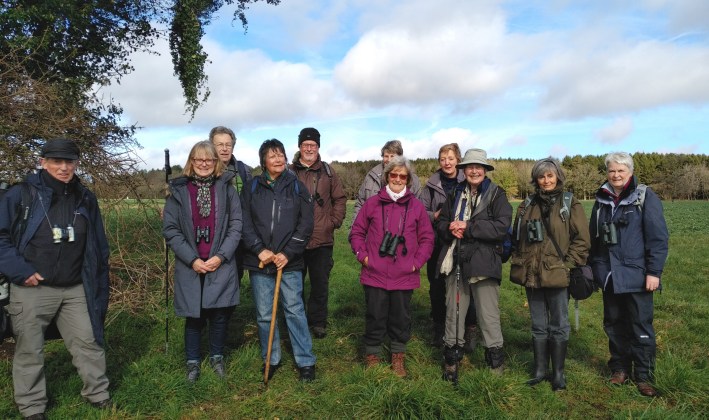
Walking up to St
Hubert's, we enjoyed the acrobatics and song of three
sky larks, we saw several yellow hammers and a green
finch in the nearby trees, and we heard blackbirds and
a song thrush singing. We had a good view of a yellow
hammer, a bit further on, sitting in a nearby tree and
singing for us.
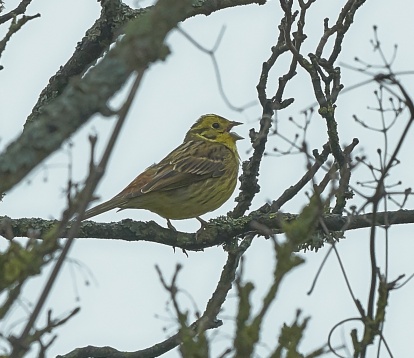
A red kite flew over
head behind us and a few ravens flew over the woods in
front of us.
Going through the
gate, over a very slippery dodgy stile and across the
field to the woods, we walked past the old ice store
of the original Idsworth House. A goldcrest flitted
back and forth in a nearby bush and we wondered if it
was bullfinches we were seeing a bit further away. We
enjoyed watching 8 or 10 deer across the field,
standing very still.
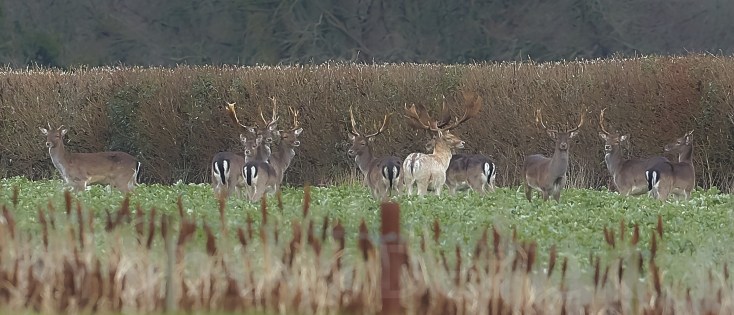
We walked up through
the woods, carpeted already with the early leaves of
wild garlic, and with primroses, celandines, spurge
laurel, red dead nettle and dog's mercury all near the
path. We had splendid views of two great spotted
woodpeckers, on tree trunks not far away.
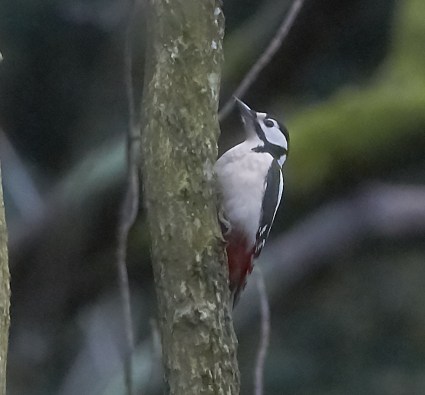
Heather heard a tree
creeper but we didn't see it. The other side of the
woods, we walked across a few fields, where we saw
redwings in the bushes, and Med gulls and a buzzard
overhead. On through a farm yard and along another
track. The clouds gave way to sunshine in time for our
coffee break, giving us great views of Portsmouth and
the Isle of Wight. A chaffinch sang for us.
We retraced our steps, back to St Hubert's, seeing
more birds along the way, including more kites, larks,
a buzzard, a kestrel, pied wagtails, long tailed and
blue tits, dunnocks and crows. We heard the yaffle of
the green woodpecker several times, but didn't see
it.
Other flowers included groundsel, ivy leafed and field
speedwell and bitter cress. We saw interesting yellow
fungi on a branch, which Ros told us was yellow brain
fungus, or more properly 'tremella mesenterica'.
SATURDAY
February 23 2019 - Baffins and Milton
An amazing
thirteen people gathered in the car park to visit
Baffin's Pond and Milton Common . It was a perfect
February day , blue sky , sunshine and no wind . In
the bordering bush were our usual gathering of
sparrows . We approached the pond through the little
wooded area , where squirrels abound and there is a
nice display of snowdrops . First bird of note was a
Heron sitting in a tree on the island - no sight of a
cormorant . Numerous tufted ducks , black headed gulls
, mallards , reduced numbers of Canada's , a possible
Barnacle Goose , shovelers , coots and a moorhen up a
tree ! A white duck and a white goose were seen .Time
was spent examining the alder trees , comparing their
catkins as some were much longer than others , could
it be due to age or different varieties ?
We then made our way to the Milton foreshore . Plenty
of bird song on the way : sparrows , great tits , blue
tits , dunnocks , wren , goldfinch and green finch -
good to hear . Heather saw a great spotted woodpecker
flying over the Brent goose field , which contained a
single Brent goose plus a number of pied wagtails .The
tide was still well out when we reached the shore .
There were the usual sea birds : Brent , many , with
an eye catching fly past , oyster catchers , red shank
, curlew , shell duck , common gulls , as well as
black headed . Coffee was at the memorial , in the
sunshine , almost too pleasant to leave .
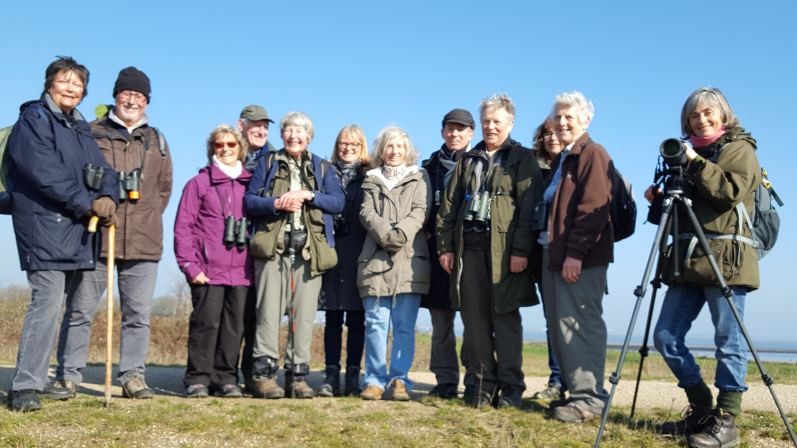
As we started off
again swans flew over us , quite a sight . Noted a
little grebe on one of the lakes plus coots , moorhen
, swans . Cettis could be heard in the bushes and
black birds , dunnocks , starlings were flying around
. We came across a lovely patch of sweet violets and a
glorious display of white flowering plumb cherry
bushes . Other plants : daisies , white comfrey , red
dead nettle , shepherds purse , gorse .Plus a dark
butterfly , possibly a red admiral and our first
bright yellow brimstone of the year .On the return
journey a kestrel was seen and Caroline spotted a
sparrow hawk when back in the car park .A lovely
morning , enjoyed by all
SATURDAY
February 16 - 2019
-
Chidham
Ros Norton
reported on this morning's walk :
A group of twelve met at Chidham car park for a walk
south to Cobnor Point on an overcast but mild day. We
heard a wren and skylarks singing also a robin and
yellowhammer. It was soon after high tide and a good
number of brent geese were seen in the harbour. Other
birds included a little egret, curlew, redshank,
mallards, shelducks, crow, kestrel , magpie,
stonechat. A large number of wood pigeons were sharing
a tree and a rabbit was seen.
Male and female
Reed Buntings
Around the Activities
Centre we saw a goldcrest, blackbirds, green
woodpecker, blue and great tits, a black tailed
godwit, another curlew and more brent.
We heard chaffinches ,
greenfinches and the drumming of a greater spotted
woodpecker. Further south towards Cobnor Point we saw
greenshank, turnstones, black backed gull, herring
gulls, common gulls and black headed gulls. There was
a large number of dunlin, 3 mergansers, cormorants,
rock pipits, teal, wigeon, lapwings, and grey plover.
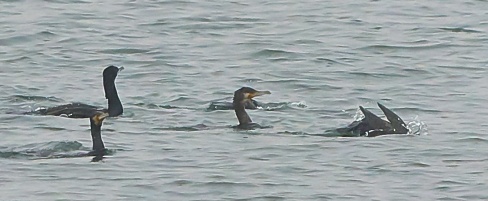
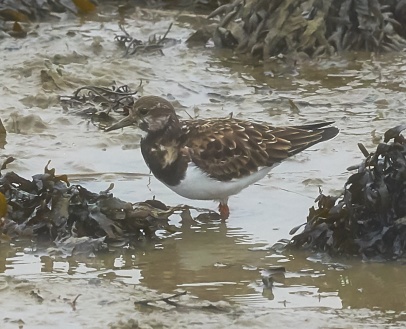
Flowers included
butchers broom, winter heliotrope, annual mercury,
gorse, daisy , dandelion, mayweed, a yellow crucifer,
groundsel ,field speedwell, red deadnettle, ,primrose,
snowdrops . We noticed the small red female catkins
near the dangling male catkins on some hazel
bushes.
SATURDAY
February 9 - 2019
-
Nutbourne
Heather Mills
reports on this morning's walk by the Havant Wildlife
Group Eight met on a blustery morning which was set to
intensify as we ventured along the shoreline.
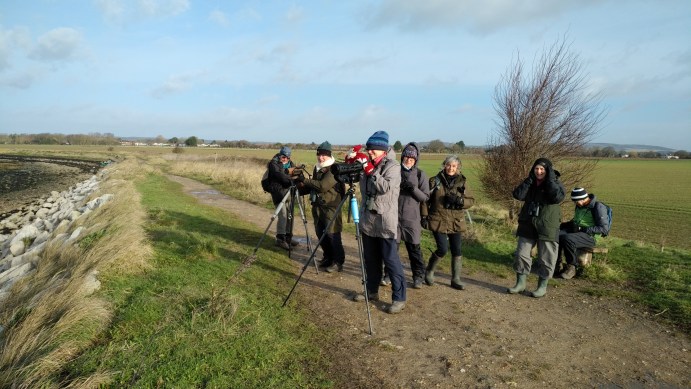
However, not before we
saw 3 welcome Common Snipe in the field
alongside the footpath.
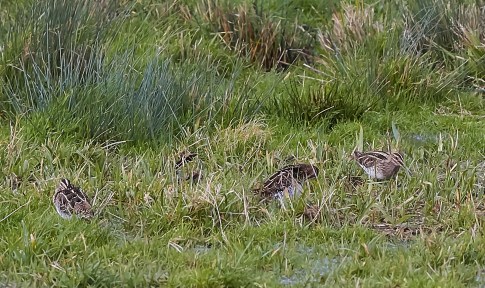
Teal and numerous
Moorhens with a few Mallard around the vicinity of the
stream. A male Green Woodpecker constantly
called and we later got lucky in seeing it descend
from the distant dead tree, choosing a tree trunk
fairly close-by in the neighbouring old orchard, with
a possible female in attendance which quickly
disappeared.
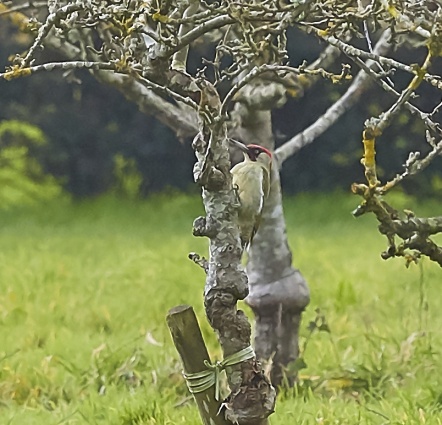
As we assembled at the
head of the footpath overlooking the outgoing tide, a
flock of Avocets approximately 30 plus counted
by Caroline, were seen at the water's edge.
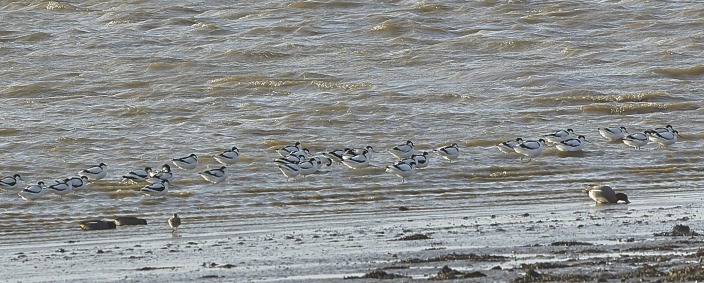
A Curlew and a few
Redshank with Grey Plover and also Wigeon, Brent and a
small flock of Pintail were seen. Caroline also noted
the first of many Ringed Plover which flew in as we
ventured to go in an easterly direction for a change.
Dunlin flocks and Oystercatchers also seen with more
Grey Plovers. Unfortunately due to the gusty
conditions we made a decision to retrace our steps.
This was the first time we have curtailed one of our
walks due to prevailing conditions. A Meadow Pipit and
probable Skylark flew across and about 20 Lapwing took
to the sky as we turned around. We retraced our steps
to go westward along the footpath into the orchard
area. Hearing the many House Sparrows hereabouts is
always welcome. Soon settling to have a welcome coffee
and catch up with a calling Great Spotted
Woodpecker
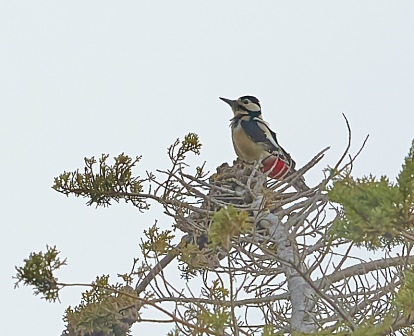
, and numerous calling
Great Tits with a lone Song thrush, intermittently
singing in a Lombardy Poplar. A Kestrel settled on a
stump of a dead fir tree in the distance. Plants seen
Gorse, Annual Mercury pointed out by Ros and Red
Deadnettle. And Snowdrops.
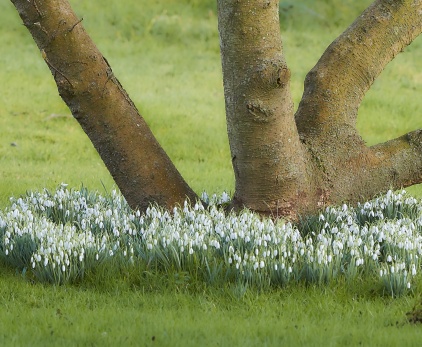
SATURDAY
February 2 - 2019
-
Warsash
Steph Dale
reported the walk. It was a very cold day with an even
colder wind but 6 of us turned up for the walk at
Warsash. Luckily the sun came out for the morning - it
didn't warm us at all but cheered us all up and made
birdwatching along this lovely path very enjoyable. We
walked up part of the River Hamble path northwards and
returned the same way, this time facing into the sun!
The tide was high.
At the start we spotted a little grebe and some wigeon
who were trying to feed but were getting disturbed
every time someone walked by on the path (Quite a few
joggers and walkers were out). Nearby we noticed gorse
in flower.
As we walked we saw birds on either side of the path,
some on the sea side and some on the lakes. We saw a
lot of Brent geese, wigeon and teal. We also saw grey
plovers, mostly among large numbers of dunlin resting
on the edge of the lakes. On the way back we noticed
knots with them too. We got a lovely view of two
greenshanks reasonably close by. Black-tailed godwits
were feeding on the edge of the lakes, as were
shelduck, redshanks, curlews and turnstones. A couple
of rock pipits flitted about.
A heron passed over, as did a buzzard later. Heather
spotted a roe deer resting on the far side of the
lakes, by the edge of a forest.
Other birds seen were oystercatchers, cormorant,
lapwings and mallard. We looked for golden plover and
kingfishers but no luck.
After a coffee break we headed further north but were
not seeing many birds so we turned round and headed
back. We met a lady from Bird Aware Solent and stopped
for a chat. She mentioned that a seal is often seen in
the area.
Thank you to those who turned up and thank you
especially to those whose who very kindly brought
their telescopes and shared them.
SATURDAY
JANUARY 26 - 2019
-
Cams
Hall
Fay Durant
reported on today's walk
A small group of ladies met at Cams Hall this morning
. Weather surprisingly mild , grey , with patches of
sunshine . We waited for most of the joggers to
disperse before setting off , walking south along the
edge of Fareham creek . Tide was relatively low .
There were swans everywhere , plus maturing cygnets
and a little Egret . Passing the Lake on the left ,
within the golf course , there was a large gathering
of Canada geese plus Brent . In the creek were Wigeon
, Teal , Oyster Catchers , Red shank , a Great black
backed gull , little grebes , Curlews , a Green shank
, Mallards and more Brent . Only one black tailed
Godwit , although a large gathering were seen earlier
in the week .
In the trees on either side of the path were various
Tits : blue, great and longtailed plus robins and
blackbirds .We continued along the path and who should
catch up with us but David . It was such a pleasure to
see him again and , as it turned out , most useful .
It was very windy , where we intended to have coffee ,
so we continued on to a more sheltered bench . There
we saw a flotilla of Red breasted Mergansers out on
the water . We went a little further along when we
heard a commotion in the wood alongside and a large
raptor flew across our path , probably a buzzard . The
tide was now far out so it was difficult to identify
any more water birds without a scope .
David offered to lead us back through the woods to Cam
Hall , a far pleasanter walk than through the estate .
It proved very interesting . We had never seen so many
bushes of butchers broom , some with berries , others
with flowers and some with both . An interesting plant
in flower was spurge laurel , pale yellow and green
flowers . We were interested in a number of trees
surrounded by a dense base of side shoots , probably
lime . The path meandered for quite a distance before
emerging at Cams Hall , from where we could descend to
the A 27 .Other plants noted : our first celandine ,
hawkweed , shepherds purse , field speedwell , yarrow
, groundsel , dandelion , daisy , a yellow crucifer ,
hazel catkins and a lovely splash of yellow gorse .A
very pleasant morning with just a few drops of rain
.Thanks to all for their efforts in identification
.
SATURDAY
JANUARY 19 - 2019 -
Farlington
Marshes
Nicola Hammond
reported this morning's walk:
10 intrepid souls met at a chilly Farlington Marshes
for this week's wildlife walk. Photos from Derek
Mills.
From the western car park we viewed a flotilla of red
breasted mergansers led by a splendid male and around
50 ringed plover were well camouflaged on the sea wall
adjoining the road. We watched a large flock of
lapwing swirling above The Point and above Hayling
Island was, what we later decided, a very big flock of
dunlin. Better was yet to come!
We walked down to the lagoon where nice views were to
be had of fairly large groups of avocet, redshank,
pintail and shelduck. High tide was at 9.40 this
morning so we were fortunate to see a large number and
range of birds on the marshes, including widgeon,
teal, lapwings, shelduck, moorhen, scattered curlew,
some greenshank, black tailed godwits, little grebes,
shovellers, Brent and Canada geese and a lone Greylag
goose.
Shelduck
with mystery pale duck. What is
is?
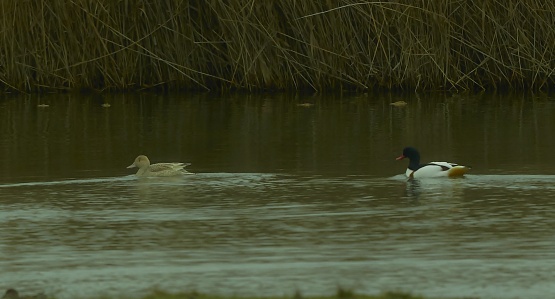
Smaller birds included
starlings, stonechats, dunnock, pied wagtail and rock
pipits. From the Point area we viewed a small island
which was crammed with dunlin, grey plover and
a few black tailed godwits and oyster catchers.

Turnstones were doing
what turnstones do along the edges. Looking back we
had nice views of a marsh harrier skimming along the
top of the reeds.
We took a coffee break on the eastern side of the
point field where alongside was another very small
island populated by dunlin and grey plover. Suddenly a
glittering mass of birds came weaving and swirling
back and forth, all trying to cram onto the island as
well. They were Bar-tailed Godwits!
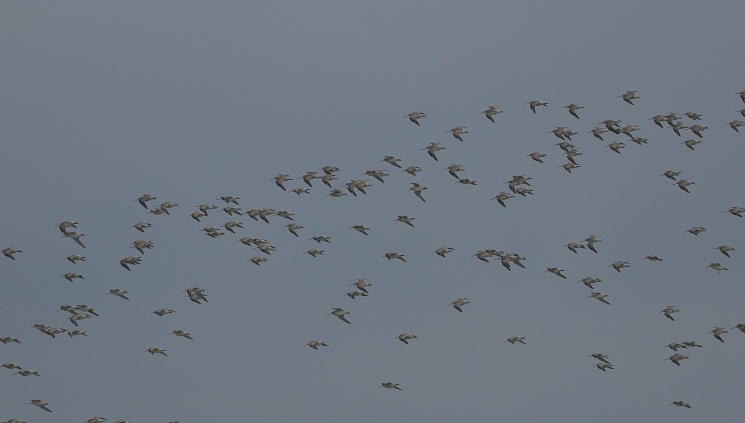
It was a wonderful
sight and we were also treated to large flocks of
lapwing giving aerial displays, assisted at times by
starlings. Heather also spotted a peregrine perched on
a post in the distance.
As we walked down the eastern sea wall we met a chap
doing a count of the Brents and he pointed out a
peregrine which was perched on the ground in the
marshes and also two ravens. We continued along the
path by the hut where we saw a kestrel and had more
excellent views of the marsh harrier. The final treat
was a reed bunting feeding on reed seeds, spotted by
Heather.
The shared eyes, knowledge and enthusiasm of everyone
attending always makes such a rewarding morning,
despite the weather!
SATURDAY
JANUARY 12 - 2019 - Bosham
Valerie
Mitchell reported on this morning's walk
13 members met at Bosham, to try a new walk for our
group, we walked past the Church and then along the
shore in a Northerly direction, tide was extremely low
so birds were at a distance.
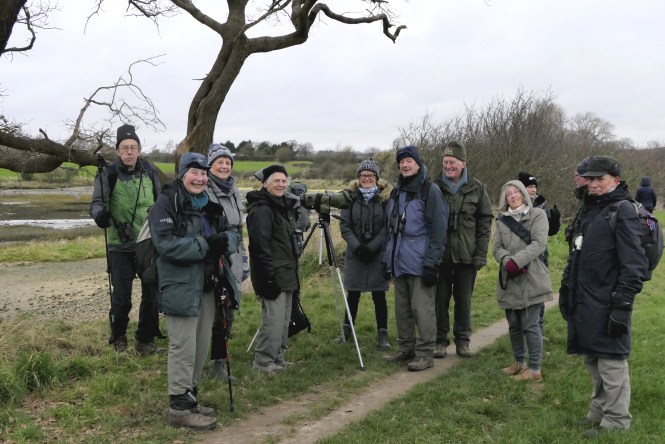
Initially we watched a
huge flock of swans flying, then a crow flying up
several times in an attempt to drop mussel on to the
concrete jetty to open it, then a kingfisher flew by
low over the water - well spotted by Heather.
Proceeding along the shore we saw little grebes, large
flock of Brent geese, oyster catchers, pintails,
wigeon, teal, black tailed godwits, large flock of
knots, curlews and a kestrel having several attempts
at catching prey. A wandering fox was spotted on the
far shore.
After joining the
footpath along the edge of the field, we had coffee
along a broken part of the banking. a large flock of
lapwings flew in, we returned via a footpath before
joining the shore again. We saw a mixed flock of grey
and ringed plovers, about 20 cormorants swimming
along, diving down for fish, a green and red shank
together at water's edge, a lone avocet, turnstones
and dunlins.
A walk worth doing
again, at a slightly higher tide.
SATURDAY
JANUARY 5 - 2019 - North Thorney
Helen Penfold
reported on this morning's walk
Sixteen of us (is that a record?) braved the cold to
walk at Thorney this morning. Soon after leaving the
car park at Thornham Lane we heard two water rails
calling to each other, but despite looking for a
while, we were not able to see either of them. There
was very little bird life in the hedgerows on the way
to the shore, but we saw more, once we'd got to the
sea. A kingfisher flew in front of us, which was a
good start, a lapwing pottered at the shore line and a
sandwich tern sat on a buoy.
We walked southwards along the top of the west Thorney
bank for a while and saw a few birds, including black
headed gulls, other gulls, oystercatchers, little
grebe and dunlin and possibly plovers on the sand
ridge some way out to sea. But the wind was keen and
we were more sheltered when we moved down from the
ridge.
There were plenty of birds on the deeps, including
teal, pochard, wigeon, shovelers, gadwall, tufted
ducks, little grebe, green shank, a pair of golden eye
and shelduck.
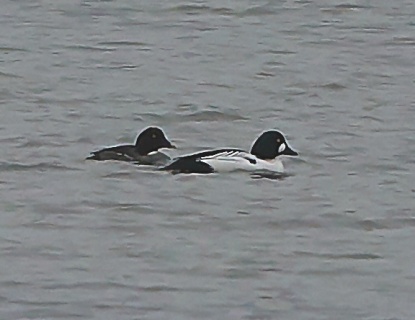
There were lots of
Brent geese, a few curlew and lapwings pottering in
the fields and a few little egrets and cormorants on
the mudbanks. As we walked to the far end of the
deeps, we had a wonderful view of another kingfisher
sitting on the fence for a long time before it flitted
backwards and forwards a bit, before disappearing into
the bushes.
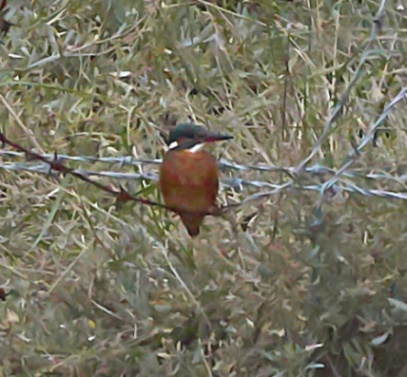
While we drank our
coffee we enjoyed watching a great black backed gull
struggling to eat the plaice it had in its mouth.
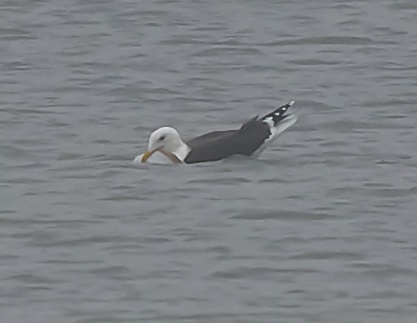
Two snipe flew down
and landed briefly, just in front of us, on the mud
flat. A buzzard sat in a bush far away, across the
water. As we walked back a flock of oyster catchers
flew above us, and several red shanks were flying up
and down the stream. A merlin and another buzzard were
seen flying in the distance by some of us.
Having got back towards the car park, we decided to
walk northwards up to the Sussex Brewery carpark where
waxwings were sighted yesterday. Sadly we didn't see
the waxwings but we enjoyed all the house sparrows in
the hedge and had great views of redwings, thrushes
and blackbirds in the fields on the way to and back
from the pub. Goldfinches were mixed in with the
redwings, in the second field, making a pretty site. A
chaffinch was close to the hedge.
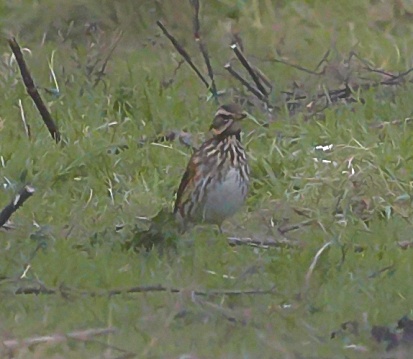
So although we were
disappointed not to see the waxwings, we did see a lot
of other birds and had a very good walk.
FOR
EARLIER REPORTS GO TO . . 2018
Sep-Dec